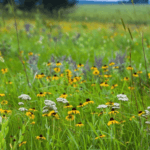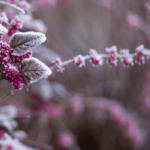
Beautiful flowers gardenia Plants For Your homes

Are you searching for a flowering shrub that will brighten your garden? The Rose of Sharon (Hibiscus syriacus) is your answer. It’s a deciduous shrub from the mallow family. This shrub is easy to care for and boasts vibrant summer blooms in colors like light blue, white, pink, red, and lavender.
The Rose of Sharon can grow quite tall, reaching 8-10 feet, and wide, up to 4-6 feet. It’s perfect for hedges, screens, or as a garden centerpiece. Its flowers can be as big as 3-5 inches, adding a stunning touch to your garden. This shrub does well in USDA zones 5-9 and loves full sun and well-drained soil.
This shrub is loved for its simple care and long blooming season. It’s perfect for both seasoned gardeners and beginners. The Rose of Sharon will surely amaze you with its beauty and reliability.
The Rose of Sharon is a stunning flowering shrub loved by gardeners worldwide. Known scientifically as Hibiscus syriacus, it has been a favorite for centuries. Its vibrant blooms and tough nature have won over many hearts.
Hibiscus syriacus, or the Rose of Sharon, belongs to the mallow family, known as Malvaceae. This family also includes hibiscus, cotton, and okra. They all have five-petaled flowers and leaves with deep lobes.
The Rose of Sharon has its roots in Asia, where it’s been grown for ages. Portuguese traders brought it to Europe in the 16th century from China. It then made its way to North America and other parts of the globe, winning over gardeners with its beauty and resilience.
Through selective breeding, many varieties have emerged. These offer different flower colors and sizes for various garden styles. Today, the Rose of Sharon is a symbol of beauty and adaptability in gardens everywhere.
| Characteristic | Description |
|---|---|
| Height | 8 to 12 feet |
| Spread | 4 to 10 feet |
| Growth Rate | Slow |
| Fruit Length | 0.5 to 1 inch |
| USDA Hardiness Zones | 5B through 9A |
| Leaf Blade Length | 2 to 4 inches |
Rose of Sharon is a favorite in gardens for its beauty and versatility. These shrubs grow tall and wide, adding beauty to any garden. They are loved by gardeners for their stunning looks.
Rose of Sharon shrubs can grow from 6 to 16 feet tall and spread 2 to 10 feet wide. They have an upright shape and sturdy stems. This makes them a great choice for adding height and interest to your garden.
The leaves of Rose of Sharon are unique, with deep lobes that add texture. These leaves are medium to dark green. They provide a beautiful backdrop for the vibrant flowers that bloom in summer and fall.
Rose of Sharon flowers come in many colors and types. You can find them in pink, white, red, lavender, and blue. These flowers are shaped like trumpets and can be single or double, with some having ruffled petals.
| Flower Color | Varieties |
|---|---|
| White | White Chiffon, Lil’ Kim |
| Pink | Pink Chiffon, Ruffled Satin |
| Red | Red Heart |
| Lavender | Dark Lavender Chiffon, Orchid Satin |
| Blue | Blue Chiffon, Azurri Blue Satin |
| Purple | Purple Pillar, Purple Satin |
Rose of Sharon offers many options for garden beauty. You can use them as a standalone plant, a hedge, or a backdrop for other plants. These shrubs are sure to impress everyone who sees them.
To make sure your Rose of Sharon grows well, you need to give it the best growing conditions. This beautiful shrub is known for its bright flowers and can be a great addition to any garden with the right care.
Rose of Sharon likes soil that drains well and is full of nutrients. It can grow in many soil types, but adding compost can help with drainage and health. The best soil pH is slightly acidic to neutral, between 3.7 and 7.3. Check your soil with a test and adjust it if needed before planting.
For lots of flowers, put your Rose of Sharon in full sun. It needs at least six hours of direct sunlight daily. Some varieties can get quite tall, up to 12 feet, so think about their size when choosing a spot.
Water your new Rose of Sharon regularly during its first year. Aim for at least one inch of water per week from rain or irrigation. As it grows, it can handle drought better, but regular watering keeps it healthy.
Rose of Sharon doesn’t need much food but can grow better with some fertilizer. Use a balanced fertilizer in early spring for a boost. For best results, pick a fertilizer made for flowering shrubs, like Pennington UltraGreen Palm Tree and Hibiscus Plant Food 9-4-9, and follow the instructions.
| Characteristic | Requirement |
|---|---|
| Soil Type | Well-drained, nutrient-rich |
| pH Level | 3.7 to 7.3 (slightly acidic to neutral) |
| Sun Exposure | Full sun (at least 6 hours of direct sunlight per day) |
| Watering | 1 inch per week during the first growing season |
| Fertilizing | Balanced, all-purpose fertilizer once in early spring |
Give your Rose of Sharon the right soil, sun, and care, and you’ll get beautiful flowers all summer. This shrub is versatile and hardy, making it a favorite among gardeners. For more ideas on using Rose of Sharon in your garden, visit Flowers Gardenia.
The Rose of Sharon is a tough and flexible shrub that does well in many climates. It’s perfect for gardeners who want to add color and beauty without the hard work. This shrub can grow in different conditions, making it a great pick for any garden.
The Rose of Sharon can handle many climates thanks to its hardiness. Most types grow well in USDA zones 5-9. In zones 5-8, it can take hot summers and humid weather. In zones 9-11, it handles mild winters.
There are different sizes of Rose of Sharon shrubs for every garden. You can find dwarf plants that are 3-4 feet tall or standard shrubs that grow over 16 feet tall and 8 feet wide. So, there’s a Rose of Sharon for every garden size and style.
The Rose of Sharon is also very good at surviving without much water. Once it’s grown, it can go through dry spells without trouble. This makes it perfect for gardens in dry areas or for those who want to save water.
Newly planted Rose of Sharons need more care, especially in dry summers. Make sure they get one inch of water each week, from rain or a hose, to help them grow strong and adjust to their new spot.
| USDA Hardiness Zone | Temperature Range | Rose of Sharon Suitability |
|---|---|---|
| 5 | -20°F to -10°F | Suitable, may need winter protection |
| 6 | -10°F to 0°F | Suitable, tolerates cold winters |
| 7 | 0°F to 10°F | Suitable, thrives in moderate conditions |
| 8 | 10°F to 20°F | Suitable, ideal growing conditions |
| 9 | 20°F to 30°F | Suitable, tolerates mild winters |
The Rose of Sharon is a great choice for gardeners who want a beautiful, easy-care garden in many climates. It’s perfect for both cold and hot, dry areas. This shrub will add joy and color to your garden for many years.
Pruning your Rose of Sharon helps it grow healthier and bloom more. It also keeps the plant looking the way you want. Pruning isn’t a must, but it really helps your shrub look great and stay strong.
The best time to prune your Rose of Sharon is in late winter or early spring. This is before new growth starts. Pruning at this time means you won’t cut off the current season’s buds, which helps you get more flowers. Here’s how to prune:
| Pruning Type | Purpose | Timing |
|---|---|---|
| Light Pruning | Good for younger shrubs | Late winter or early spring |
| Hard Pruning | Leads to fewer but bigger flowers | Late winter or early spring |
| Renewal Pruning | Helps overgrown plants by cutting out older branches | Late winter or early spring |
Deadheading isn’t needed for Rose of Sharon since the wilted flowers usually fall off by themselves. But, if you like a neat look, you can take off the spent flowers. This can make your plant bloom more throughout the season.
By using these pruning and care tips, your Rose of Sharon will stay healthy, lively, and lovely for many years. Remember, you can prune up to one-third of the plant at a time in late winter or early spring. And, your shrub can grow up to 2 feet in a season, so feel free to shape and care for your plant as needed.
The Rose of Sharon, also known as Hibiscus syriacus, is known for its stunning colors and unique flower shapes. It comes in many colors, from soft pink to deep purple. These shrubs add beauty to any garden. Let’s look at some top Rose of Sharon types that will inspire and delight you.
Sugar Tip is a favorite for its beautiful double flowers in pink and white. The flowers have pink edges that fade to white in the middle, creating a striking look. It blooms for a long time and grows well, making it great for adding sweetness to your garden. Learn more about the beauty of Sugar Tip Rose of Sharon.
For a bold look, Red Heart Rose of Sharon is perfect with its bright, ruby-red flowers. These flowers pop against the gray-green leaves, making a beautiful contrast. It’s also tough against pests and diseases, so it stays healthy and looks great.
Purple Pillar stands out with its tall, columnar shape that adds height to your garden. Its flowers are a rich purple-pink color, adding elegance. It’s great for making beautiful hedges or screens, fitting well in tight spaces. Let Purple Pillar add a regal touch to your garden.
| Variety | USDA Hardiness Zones | Height | Sun Exposure | Sterile (not self-sowing) |
|---|---|---|---|---|
| Sugar Tip | 5–8 | 5-6 feet | Full, partial | Yes |
| Red Heart | 5–9 | 8–10 feet | Full, partial | No |
| Purple Pillar | 5–9 | 10–16 feet | Full, partial | No |
These Rose of Sharon types show how diverse and beautiful this shrub is. Whether you like Sugar Tip’s delicate look, Red Heart’s bold style, or Purple Pillar’s unique shape, there’s a perfect one for your garden. Let these varieties bring vibrant colors and beautiful blooms to your landscape.
Rose of Sharon shrubs are versatile and stunning in any landscape. They grow upright, have dense foliage, and bloom vibrantly. They’re perfect for creating a beautiful backdrop, adding vertical accents, or making a stunning focal point.
Rose of Sharon is often used as a hedge or screen. When planted together, they form a colorful barrier that’s both private and beautiful. They can grow 8 to 12 feet tall and 6 to 10 feet wide. Plant them 6 to 10 feet apart to let them spread out fully.
This way, they create a living wall that’s both effective and beautiful. Enjoy their white, pink, purple, or red flowers from summer to fall.
In mixed borders, Rose of Sharon adds height and color in late summer. Their upright growth makes a striking vertical accent. This draws the eye upward and adds depth to the landscape.
Consider using them as a specimen plant or near the house in foundation plantings. This creates a focal point that will leave a lasting impression.
| Landscaping Use | Benefits |
|---|---|
| Hedges and Screens | Privacy, Dense Foliage, Colorful Blooms |
| Mixed Borders | Height, Structure, Late Summer Color |
| Focal Points | Specimen Plant, Foundation Planting |
Here are some tips for using Rose of Sharon in your landscape:
Rose of Sharon is a must-have for gardeners who want to improve their landscape. It’s easy to care for, adaptable, and incredibly beautiful.
Turn your garden into a haven for wildlife with the Rose of Sharon (Hibiscus syriacus). This beautiful shrub brings color and attracts many animals. Its big, bright flowers are perfect for pollinators.
Butterflies and hummingbirds love the Rose of Sharon’s flowers. They come for the nectar, which gives them energy. Adding this plant to your garden lets you see these creatures up close.
Bees and other pollinators also enjoy the Rose of Sharon. Bumble bees visit often because of its pollen. This helps their populations and makes your garden healthier.
| Pollinator | Attraction to Rose of Sharon |
|---|---|
| Bees | Highly attracted to the big, showy flowers with large stamens |
| Hummingbirds | Find the abundant nectar irresistible |
| Butterflies | Drawn to the vibrant colors and nectar-rich blooms |
For the best results, take good care of your Rose of Sharon. It can handle heat, pollution, and some drought. Give it moist soil, plenty of sun, and water when it’s dry to get lots of blooms.
Enjoy the beauty and importance of the Rose of Sharon. Your garden will become a place where butterflies, hummingbirds, bees, and more can thrive. Each flower helps protect our pollinators and the world we live in.
When designing your landscape with the stunning Rose of Sharon, picking the right plants is crucial. Choose plants that like the same amount of sun and can handle drought, like coneflowers and black-eyed Susans. These plants will look great with your Rose of Sharon and make your garden healthy and easy to care for.
Try different colors and textures to make your garden more interesting. Pairing Rose of Sharon with plants that have different foliage colors or textures can make your garden stand out. For example, Russian sage’s silver leaves or catmint’s delicate flowers look great with the bold blooms of Rose of Sharon.
In West Michigan, many people pair flowering shrubs like Hydrangeas with various plants. Hostas, ferns, and daylilies are some plants that work well with these shrubs. They help create beautiful landscape designs.
Think about what benefits a plant offers when choosing companions for your Rose of Sharon. Some plants attract pollinators and add color and texture to your garden. Others, like lilacs, offer a pleasant scent and colorful berries that engage all your senses.
| Companion Plant | Characteristics | Benefits |
|---|---|---|
| Coneflowers | Drought-tolerant, sun-loving | Attracts butterflies and bees |
| Ornamental Grasses | Varied textures and heights | Provides visual interest and movement |
| Russian Sage | Silvery foliage, purple flowers | Complements Rose of Sharon colors |
| Catmint | Delicate flowers, aromatic foliage | Attracts pollinators, drought-tolerant |
Choosing the right plants for your Rose of Sharon can make your landscape beautiful and healthy. Explore different colors, textures, and plant combinations to create a unique and captivating garden. This will bring you joy for many years.
The Rose of Sharon is usually easy to care for and doesn’t have many problems. But, it can sometimes face pests and diseases. Knowing how to protect your garden can help.
Aphids, like the rose aphid, can be a problem for your Rose of Sharon. These tiny bugs can grow in large numbers quickly. Luckily, natural enemies like wasps and ladybugs can help control them. If you need to act, you can spray them with water or insecticidal soap.
Japanese beetles are another pest to watch for. They can eat your Rose of Sharon from mid-May to August. To fight them, you can pick them off by hand or use fine netting. Applying Milky Spore can also help control the grubs in your lawn.
Fungal diseases can also harm your Rose of Sharon, especially in damp places. Look out for leaf spot and other diseases. To prevent these, keep your garden clean and make sure air moves well around your plants. Using a mix of pest control methods can also help.
| Pest/Disease | Symptoms | Control Measures |
|---|---|---|
| Aphids | Clusters of small, soft-bodied insects on new growth and undersides of leaves | Hose off with water, use insecticidal soap or contact insecticides |
| Japanese Beetles | Skeletonized leaves, damaged flowers and buds | Handpick, use fine netting, apply Milky Spore to control grubs |
| Leaf Spot | Circular or irregular spots on leaves, often with dark margins | Remove infected leaves, improve air circulation, avoid overhead watering |
| Powdery Mildew | White, powdery fungal growth on leaves and stems | Improve air circulation, remove infected foliage, use fungicides if needed |
Prevention and catching problems early are key to a healthy Rose of Sharon. Check your plants often for any signs of trouble. By using a mix of methods, you can keep your Rose of Sharon looking great all season.
Expanding your Rose of Sharon collection is easy and rewarding through two main methods: stem cuttings and seed sowing. These techniques let you create a diverse and thriving garden with these stunning flowering shrubs.
Stem cuttings are a reliable way to grow more Rose of Sharon plants. You can take softwood cuttings in spring or early summer, or hardwood cuttings in late fall or winter. Use rooting hormone on the cut end to help roots grow.
Plant the cuttings in a well-draining potting mix. Keep the soil moist and warm until they develop roots and show new growth. About a third to a half of the cuttings will root and become new plants in a month or two.
When propagating Rose of Sharon cuttings in water, roots will grow 1 to 2 inches long before moving to soil. This method lets you easily check on root growth and helps plants adjust to the garden or container smoothly.
Growing Rose of Sharon from seeds is exciting and introduces genetic diversity to your garden. Collect seeds in late summer or fall when pods are ripe and brown. Each pod has three to five seeds, which will spread out when the pod opens.
Sow seeds directly in the garden in fall or early spring, or start them indoors for later transplanting. Plant seeds ¼ to ½ inch deep in rich, fertile soil. Provide full sun and consistent moisture for best results. Seeds germinate in 2 to 3 weeks, and seedlings grow to 6 to 8 inches tall by summer, ready for their garden spot.
| Propagation Method | Timing | Success Rate |
|---|---|---|
| Softwood Cuttings | Spring to Early Summer | 33% to 50% |
| Hardwood Cuttings | Late Fall to Winter | 33% to 50% |
| Seed Sowing | Fall or Early Spring | High, up to 200 seedlings |
By using stem cuttings and seed sowing, you can grow more Rose of Sharon plants. You can share them with others and help your local ecosystem. Seeds left on the plant in winter feed birds, making your garden beautiful and supporting wildlife.
The Rose of Sharon is a standout shrub that adds beauty and versatility to gardens. It has vibrant colors and blooms for a long time. This plant is perfect for gardeners who want elegance and charm in their gardens.
It thrives in the heat of August, making it great for adding color in late summer. Despite its name, which suggests it comes from Syria, it actually comes from China. This fact adds mystery to its history.
The Rose of Sharon is linked to the Bible and Korean culture, making it more special. Whether you plant one or many, it will inspire your garden. It looks like the European tree mallow and attracts butterflies and hummingbirds.
Adding the Rose of Sharon to your garden means you get beauty with little work. It will inspire and delight you for many years.




